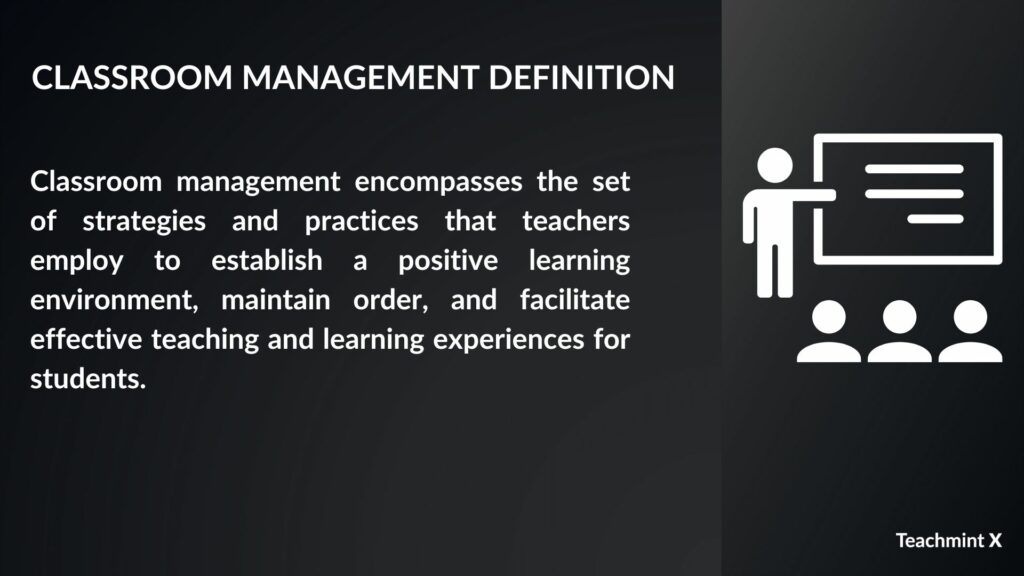The concept of classroom management has long been an important aspect of teaching. The classroom management definition can simply be stated as the maintenance of a positive classroom environment. Similarly, classroom management meaning, can also be referred to as maintaining a learning environment that can help improve the scope of teaching.
In simple terms, the classroom management definition can be given as: Classroom management is a strategy that consists of several methods, like differentiated instruction and agile learning. The classroom management meaning also takes into account the teachers’ attitude where he/she controls the classroom environment to maintain discipline, respect, consistency, and proximity.
It is important to have complete clarity about classroom management meaning, because through that it will be possible to outline the various actions associated with it.
When talking about the classroom management definition, it mostly means the process that is being used to improve the methods of teaching. However, when talking about the real meaning of classroom management meaning, it refers to a host of other factors. These include making decisions about the structure, the course activities that will be included, the syllabi structure and organization.
Each of these factors will need to be provided with proper consideration, as it will be responsible for managing the expectations and behavior of the students.
Differentiated instruction means providing instructions as per individual needs. It creates a better learning experience for the parties concerned. Simultaneously, agile learning helps create an atmosphere of collaborative learning, teaching students how to break down problems into bite-size issues and solve them. Agile learning is more into practical skills than theory.
The classroom management definition also includes what kind of techniques are being used by the teachers to simplify the process of teaching. These techniques include methods such as addressing student behavior, establishing guidelines, managing documentation through digital methods and so on.
Some classroom management techniques also include a block-scheduling system (varies from school to school). The system replaces two to three subjects having shorter hours with one subject for long hours. For example, there is a Science class of 30 minutes, six times a week. With block scheduling, teachers make it 1 hour 3 times a week. Block scheduling allows the teacher to complete the subject on time, and with the long hours, it doesn’t break the subject’s continuity.
While the world is also slowly shifting toward homeschooling, it is vital to apply classroom management for the home tutor. Making the corner of the home space look like a classroom. Management helps to bring in decorum.
The education supplement is a part of classroom management. College remediation is a part of the education supplement where students with low grades or deficient in particular subjects are sent to a class or a group, where they are helped in achieving better results and learn better.
Classroom management strategies
Classroom management definition can be explained in various ways. Classroom management meaning is a strategy that consists of several methods, like differentiated instruction and agile learning. Let’s discuss a few classroom management strategies in detail below:
Set rules and regulations- Documenting rules in the classroom is highly essential. It ensures discipline in the classroom. Classroom management meaning is to make sure that the needs of every student are fulfilled and a proper decorum is maintained in the class.
Encouraging the students to take initiative- It is necessary to promote taking initiative in the classroom. This ensures the growth of the students in every aspect. It is the most fundamental part of classroom management definition to promote a growth mindset.
Give rewards- Giving rewards to students can develop a motivational atmosphere in the classroom. Students will participate actively in the classroom.
Interview students- It is really important to get to know about students’ needs and wants. In order to achieve the objective of classroom management meaning, teachers must interview students to get to know them better about their performance in the classroom.
Introduce peer learning- Students learn best by interacting with each other. Group learning or peer learning must be encouraged in the classroom as a classroom management strategy to help students learn more effectively. Peer learning improves the self-esteem and interpersonal skills of the students and helps in achieving classroom management meaning.
Why is classroom management important?
Classroom management definition is the process that teachers use to make sure that a classroom runs properly. The importance of classroom management is that it creates a long-term learning environment in the classrooms. It facilitates meaningful academic learning and fosters social-emotional growth. Classroom management definition is a very vast concept but it has various benefits.
The classroom management also includes extrinsic motivation at the end of every week, where students with the highest scores are rewarded with extra grades or badges. It motivates them to study more. For example, Stanton High School’s classroom management follows an alternate day block schedule. Students take three topics of the science subject of 120 mins in each class, which comprises 60 mins theory and 60 mins practical sessions of biology, chemistry, and physics sessions.
Hence, it can be concluded that classroom management definition has many facets to it. It not only involves the ability of the teachers to improve their skills when giving educational instructions to the students. At the same time, it also involves their ability to maintain classroom decorum and promote model behavior.
The classroom management meaning also has both intrinsic and extrinsic motivation present. While the extrinsic motivation remains for the students to be rewarded for their hard work, the intrinsic motivation remains to improve the skills of the students. The universal goal of this strategy is to create an environment that will encourage students to become more engaged with their classes.
For More information, Please Visit the Website


